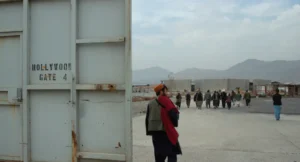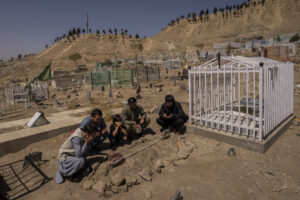Violent Chaos Is Practically American Foreign Policy
When it comes to wreaking havoc in the Middle East, Donald Trump has more in common with his predecessors than many are willing to admit. Secretary of State Mike Pompeo. (Mark Taylor / Flickr)
Secretary of State Mike Pompeo. (Mark Taylor / Flickr)
This piece originally appeared on TomDispatch.
In March 1906, on the heels of the U.S. Army’s massacre of some 1,000 men, women, and children in the crater of a volcano in the American-occupied Philippines, humorist Mark Twain took his criticism public. A long-time anti-imperialist, he flippantly suggested that Old Glory should be redesigned “with the white stripes painted black and the stars replaced by the skull and cross-bones.”
I got to thinking about that recently, five years after I became an antiwar dissenter (while still a major in the U.S. Army), and in the wake of another near-war, this time with Iran. I was struck yet again by the way every single U.S. military intervention in the Greater Middle East since 9/11 has backfired in wildly counterproductive ways, destabilizing a vast expanse of the planet stretching from West Africa to South Asia.
Chaos, it seems, is now Washington’s stock-in-trade. Perhaps, then, it’s time to resurrect Twain’s comment — only today maybe those stars on our flag should be replaced with the universal symbol for chaos.
After all, our present administration, however unhinged, hardly launched this madness. President Trump’s rash, risky, and repugnant decision to assassinate Iranian Major General Qassem Suleimani on the sovereign soil of Iraq was only the latest version of what has proven to be a pervasive state of affairs. Still, that and Trump’s other recent escalations in the region do illustrate an American chaos machine that’s gone off the rails. And the very manner — I’m loathe to call it a “process” — by which it’s happened just demonstrates the way this president has taken American chaos to its dark but logical conclusion.
The Goldilocks Method
Any military officer worth his salt knows full well the importance of understanding the basic psychology of your commander. President George W. Bush liked to call himself “the decider,” an apt term for any commander. Senior leaders don’t, as a rule, actually do that much work in the traditional sense. Rather, they hobnob with superiors, buck up unit morale, evaluate and mentor subordinates, and above all make key decisions. It’s the operations staff officers who analyze problems, present options, and do the detailed planning once the boss blesses or signs off on a particular course of action.
Though they may toil thanklessly in the shadows, however, those staffers possess immense power to potentially circumscribe the range of available options and so influence the future mission. In other words, to be a deft operations officer, you need to know your commander’s mind, be able translate his sparse guidance, and frame his eventual choice in such a manner that the boss leaves a “decision briefing” convinced the plan was his own. Believe me, this is the actual language military lifers use to describe the tortured process of decision-making.
In 2009, as a young captain, fresh out of Baghdad, Iraq, I spent two unfulfilling, if instructive, years enmeshed in exactly this sort of planning system. As a battalion-level planner, then assistant, and finally a primary operations officer, I observed this cycle countless times. So allow me to take you “under the hood” for some inside baseball. I — and just about every new staff officer — was taught to always provide the boss with three plans, but to suss out ahead of time which one he’d choose (and, above all, which one you wanted him to choose).
Confident in your ability to frame his choices persuasively, you’d often even direct your staffers to begin writing up the full operations order before the boss’s briefing took place. The key to success was what some labeled the Goldilocks method. You’d always present your commander with a too-cautious option, a too-risky option, and a “just-right” course of action. It nearly always worked.
I did this under the command of two very different lieutenant colonels. The first was rational, ethical, empathetic, and tactically competent. He made mission planning easy on his staff. He knew the game as well as we did and only pretended to be fooled. He built relationships with his senior operations officers over the course of months, thereby revealing his preferred methods, tactical predilections, and even personal learning style. Then he’d give just enough initial guidance — far more than most commanders — to set his staff going in a reasonably focused fashion.
Unfortunately, that consummate professional moved on to bigger things and his replacement was a sociopath who gave vague, often conflicting guidance, oozed insecurity in briefings, and had a disturbing penchant for choosing the most radical (read: foolhardy) option around. Sound familiar? It should!
Still, military professionals are coached to adapt and improvise and so we did. As a staff we worked to limit his range of options by reverse–ordering the choices we presented him or even lying about nonexistent logistical limitations to stop him from doing the truly horrific.
And as recent events remind us, such exercises play out remarkably similarly, no matter whether you’re dealing at a battalion level (perhaps 400 to 700 troops) or that of this country’s commander-in-chief (more than two million uniformed service personnel). The behind-the-scenes war-gaming of the boss, the entire calculus, remains the same, whether the options are ultimately presented by a captain (me, then) or — as in the recent decision to assassinate Iranian Major General Suleimani — Mark Milley, the four-star general at the helm of the Joint Chiefs of Staff.
Soon after President Trump’s egregious, a-strategic, dubiously legal, unilateral execution of a uniformed leader of a sovereign country, reports surfaced describing his convoluted decision-making process. Perhaps predictably, it appears that The Donald took his military staff by surprise and chose the most extreme measure they presented him with — assassinating a foreign military figure. Honestly, that this president did so should have surprised no one. That, according to a report in the New York Times, his generals were indeed surprised strikes me as basic dereliction of duty (especially given that, seven months earlier, Trump had essentially given the green light to such a future assassination — the deepest desire, by the way, of both his secretary of state and his then-national security advisor, John Bolton).
At this point in their careers, having played out such processes at every possible level for at least 30 years, his generals ought to have known their boss better, toiled valiantly to temper his worst instincts, assumed he might choose the most extreme measure offered and, when he did so, publicly resigned before potentially relegating their soldiers to a hopeless new conflict. That they didn’t, particularly that the lead briefer Milley didn’t, is just further proof that, 18-plus years after our latest round of wars began, such senior leaders lack both competence and integrity.
Bush, Obama, and the Chaos Machine’s Tragic Foundations
The current commander-in-chief could never have expanded America’s wars in the Greater Middle East (contra his campaign promises) or unilaterally drone-assassinated a foreign leader, without the militaristic foundations laid down for him by George W. Bush and Barack Obama. So it’s vital to review, however briefly, the chaotic precedents to the rule of Donald Trump.
Guided by a coterie of neoconservative zealots, Bush the Younger committed the nation to the “original sin” of expansive, largely unsanctioned wars as his chosen response to the 9/11 attacks. It was his team that would write the playbook on selling an ill-advised, illegal invasion of Iraq based on bad intelligence and false pretenses. He also escalated tensions with Iran to the brink of war by including the Islamic Republic in an imaginary “axis of evil” (with Iraq and North Korea) after invading first one of its neighbors, Afghanistan, and then the other, Iraq, while imposing sanctions, which froze the assets of Iranians allegedly connected to that country’s nuclear program. He ushered in the use of torture, indefinite detention, extraordinary rendition, illegal domestic mass surveillance, and drone attacks over the sovereign airspace of other countries — then lied about it all. That neither Congress, nor the courts, nor his successor held him (or anyone else) accountable for such decisions set a dangerous new standard for foreign policy.
Barack Obama promised “hope and change,” a refreshing (if vague) alternative to the sins of the Bush years. The very abstraction of that slogan, however, allowed his supporters to project their own wants, needs, and preferred policies onto the future Obama experiment. So perhaps none of us ought to have been as surprised as many of us were when, despite slowly pulling troops out of Iraq, he only escalated the Afghan War, continued the forever wars in general (even returning to Iraq in 2014), and set his own perilous precedents along the way.
It was, after all, Obama who, as an alternative to large-scale military occupations, took Bush’s drone program and ran with it. He would be the first president to truly earn the sobriquet “assassin-in-chief.” He made selecting individuals for assassination in “Terror Tuesday” meetings at the White House banal and put his stamp of approval on the drone campaigns across significant parts of the planet that followed — even killing American citizens without due process. Encouraged by Secretary of State Hillary Clinton, he also launched a new regime-change war in Libya, turning that land into a failed state filled with terror groups, a decision which, he later admitted, added up to a “shit show.” After vacillating for a couple years, he also mired the U.S., however indirectly, in the Syrian civil war, empowering Islamist factions there and worsening that already staggering humanitarian catastrophe.
In response to the sudden explosion of the Islamic State — an al-Qaeda offshoot first catalyzed by the Bush invasion of Iraq and actually formed in an American prison in that country — its taking of key Iraqi cities and smashing of the American-trained Iraqi army, Obama loosed U.S. air power on them and sent American troops back into that country. He also greatly expanded his predecessor’s nascent military interventions across the African continent. There, too, the results were largely tragic and counterproductive as ethnic militias and Islamic terror groups have spread widely and civil warfare has exploded.
Finally, it was Obama who first sanctioned, supported, and enabled the Saudi terror bombing of Yemen, which, even now, remains perhaps the world’s worst humanitarian disaster. So it is that, from Mali to Libya, Syria to Afghanistan, every one of Bush’s and Obama’s military forays has sowed further chaos, startling body counts, and increased rates of terrorism. It’s those policies, those results, and the military toolbox that went with them that Donald J. Trump inherited in January 2017.
The Trumpian Perfect Storm
During the climax to the American phase of a 30-year war in Vietnam, newly elected President Richard Nixon, a well-established Republican cold warrior, developed what he dubbed the “madman theory” for bringing the intractable U.S. intervention there to a face-saving conclusion. The president’s chief of staff, H.R. Haldeman, recalled Nixon telling him:
“I call it the Madman Theory, Bob. I want the North Vietnamese to believe I’ve reached the point where I might do anything to stop the war. We’ll just slip the word to them that, ‘for God’s sake, you know Nixon is obsessed about communism. We can’t restrain him when he’s angry—and he has his hand on the nuclear button’ and [North Vietnamese leader] Ho Chi Minh himself will be in Paris in two days begging for peace.”
It didn’t work, of course. Nixon escalated and expanded the war. He briefly invaded neighboring Cambodia and Laos, secretly (and illegally) bombed both countries, and ramped up air strikes on North Vietnam. Apart from slaughtering hundreds of thousands of innocents, however, none of this had a notable effect on the ultimate outcome. The North Vietnamese called his bluff, extending the war long enough to force an outright American withdrawal less than four years later. Washington lost in Southeast Asia, just as today it’s losing in the Greater Middle East.
So it was, with the necessary foundations of militarism and hyper-interventionism in place, that Donald Trump entered the White House, at times seemingly intent on testing out his own personal “fire and fury” version of the madman theory. Indeed, his more irrational and provocative foreign policy incitements, including pulling out of the Paris climate accords, spiking a working nuclear deal with Iran, existentially threatening North Korea, seizing Syrian oil fields, sending yet more military personnel into the Persian Gulf region, and most recently assassinating a foreign leader seem right out of some madman instruction manual. And just like Nixon’s stillborn escalations, Trump’s most absurd moves also seem bound to fail.
Take the Suleimani execution as a case in point. An outright regional war has (so far) been avoided, thanks not to the “deal-making” skills of that self-styled “stable genius” in the White House but to Iran’s long history of restraint. As retired Colonel Lawrence Wilkerson, a former top aide to Secretary of State Colin Powell, recently put it: “The leadership in Tehran is far more rational than the leadership in Washington.”
In fact, Trump’s unprecedented assassination order backfired at every level. He even managed briefly to unite a divided Iranian nation, caused the Iraqi government to demand a full U.S. troop withdrawal from that country, convinced Iran to end its commitment to restrain its enrichment of uranium, and undoubtedly incentivized both Tehran and Pyongyang not to commit to, or abide by, any future nuclear deals with Washington.
If George W. Bush and Barack Obama sowed the seeds of the American chaos machine, Donald Trump represents the first true madman at the wheel of state, thanks to his volatile temperament, profound ignorance, and crippling insecurity.
The Rapture as Foreign Policy
All of which raises another disturbing question: What if this administration’s chaos-sowing proves an end in itself, one that coheres with the millenarian fantasies of sections of the Republican Christian Right? After all, several key figures on the Trump team — notably Secretary of State Mike Pompeo and Vice President Mike Pence — explicitly view the Middle East as evangelical Christians. Like a disturbing 73% of evangelicals (or 20% of the U.S. population), Pompeo and Pence believe that the Rapture (that is, the prophesied Christian end of the world) is likely to unfold in this generation and that a contemporary conflict in Israel and an impending war with Iran might actually be trigger events ushering in just such an apocalypse.
Donald Trump is, by all indications, far too self-serving, self-absorbed, and cynical to adhere to the eschatological blind-faith of the two Mikes. He clearly believes only in Donald Trump. And yet what a terrible irony it would be if, due to his perfect-storm disposition, he unwittingly ends up playing the role of the very Antichrist those evangelicals believe necessary to usher in end-times.
Given the foundations set in place for Trump by George W. Bush and Barack Obama and his capacity to throw caution to the wind, it’s hard to imagine a better candidate to play that role.
Danny Sjursen, a TomDispatch regular, is a retired U.S. Army major and former history instructor at West Point. He served tours in Iraq and Afghanistan, and now lives in Lawrence, Kansas. He has written a memoir of the Iraq War, Ghost Riders of Baghdad: Soldiers, Civilians, and the Myth of the Surge. Follow him on Twitter at @SkepticalVet and check out his podcast “Fortress on a Hill,” co-hosted with fellow vets Chris Henriksen and Keegan Ryan Miller.
Follow TomDispatch on Twitter and join us on Facebook. Check out the newest Dispatch Books, John Feffer’s new dystopian novel (the second in the Splinterlands series) Frostlands, Beverly Gologorsky’s novel Every Body Has a Story, and Tom Engelhardt’s A Nation Unmade by War, as well as Alfred McCoy’s In the Shadows of the American Century: The Rise and Decline of U.S. Global Power and John Dower’s The Violent American Century: War and Terror Since World War II.
Copyright 2020 Danny Sjursen
Your support is crucial…With an uncertain future and a new administration casting doubt on press freedoms, the danger is clear: The truth is at risk.
Now is the time to give. Your tax-deductible support allows us to dig deeper, delivering fearless investigative reporting and analysis that exposes what’s really happening — without compromise.
Stand with our courageous journalists. Donate today to protect a free press, uphold democracy and unearth untold stories.









You need to be a supporter to comment.
There are currently no responses to this article.
Be the first to respond.